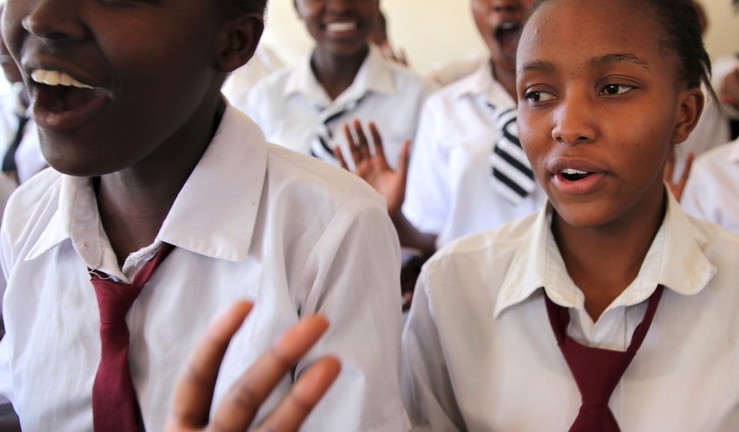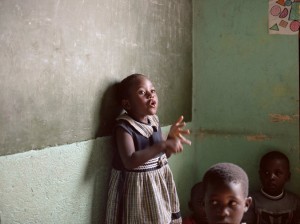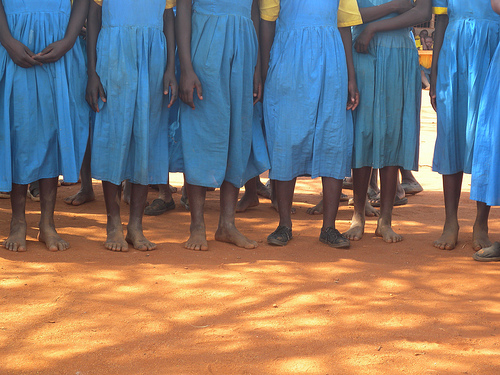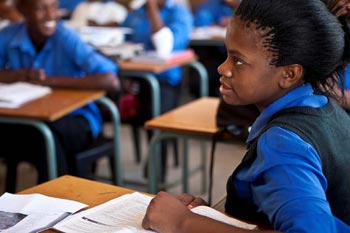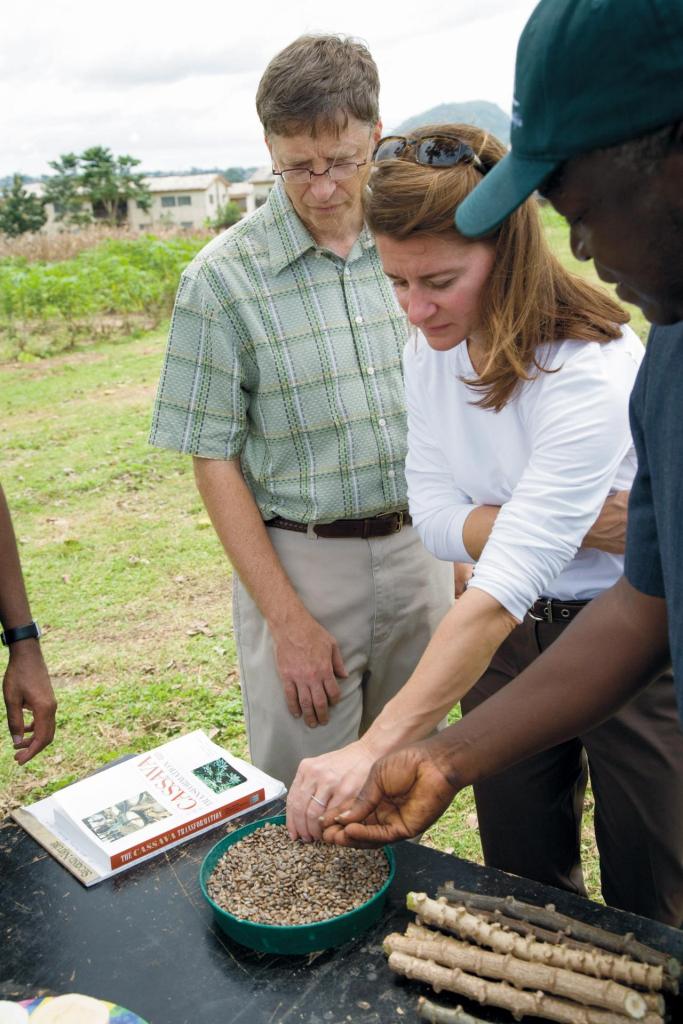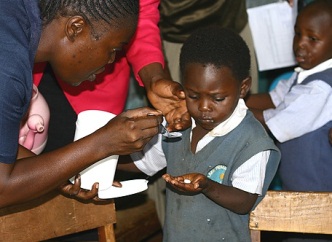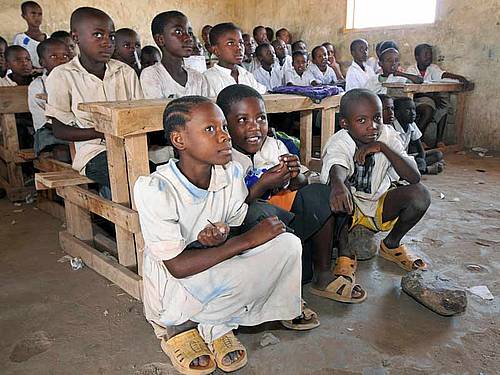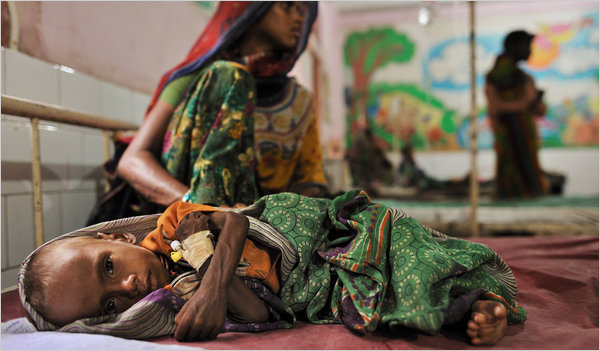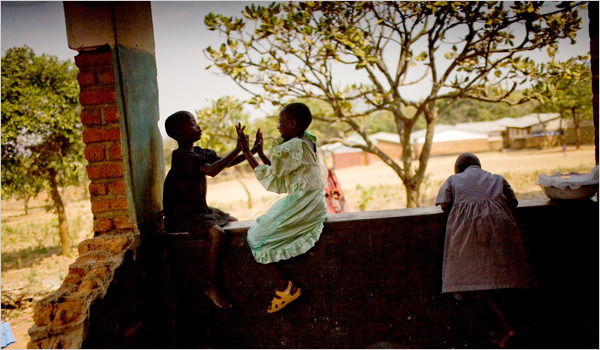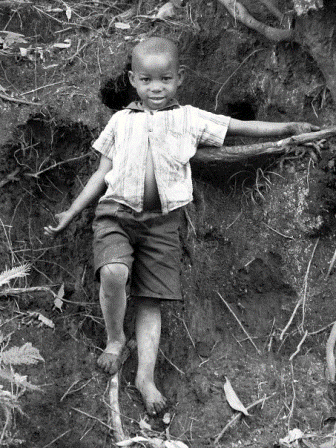Poverty, Education, & Opportunity
Please send us links to papers and other media that can serve a broad discussion about education in the developing world, and we’ll post them here.
___________________________________________________
August, 2020
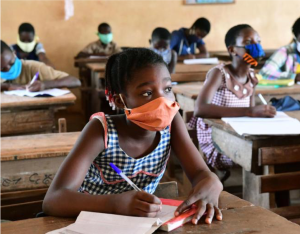 Human Rights Watch: Impact of Covid-19 on Children’s Education in Africa
Human Rights Watch: Impact of Covid-19 on Children’s Education in Africa
Human Rights Watch respectfully submits this written presentation to contribute testimony from childrHuman Rights Watch respectfully submits this written presentation to contribute testimony from children to the discussion on the impact of Covid-19 on children at the 35th Ordinary Session of the African Committee of Experts on the Rights and Welfare of the Child.
Between April and August 2020, Human Rights Watch conducted 57 remote interviews with students, parents, teachers, and education officials across Burkina Faso, Cameroon, the Democratic Republic of Congo, Kenya, Madagascar, Morocco, Nigeria, South Africa, and Zambia to learn about the effects of the pandemic on children’s education. Our research shows that school closures caused by the pandemic exacerbated previously existing inequalities, and that children who were already most at risk of being excluded from a quality education have been most affected.
___________________________________________________
___________________________________________________
November 05, 2019
Kenya and South Africa still lag behind on gender equality in education
Women still aren’t fully represented in higher education in Kenya and South Africa, despite changes in law and policy over the years. This failure of the education sector to harness and develop women’s talents curtails their ability to contribute meaningfully to society.
The constitutions in both countries guarantee every citizen a right to education. This is regardless of gender, sex, or social class. Higher education in particular holds great value for the public good. It is central to the development of individuals and nations.
But there is still uneven development between genders. In Kenya and South Africa women still struggle to access institutions of higher education. And they also struggle to succeed in science, technology, engineering, and mathematics (STEM) related courses, and to progress into postgraduate studies.
Also, see McKinsey Global Institute’s November 2019 report, The power of parity: Advancing women’s equality in Africa.
___________________________________________________
___________________________________________________
October 26, 2016
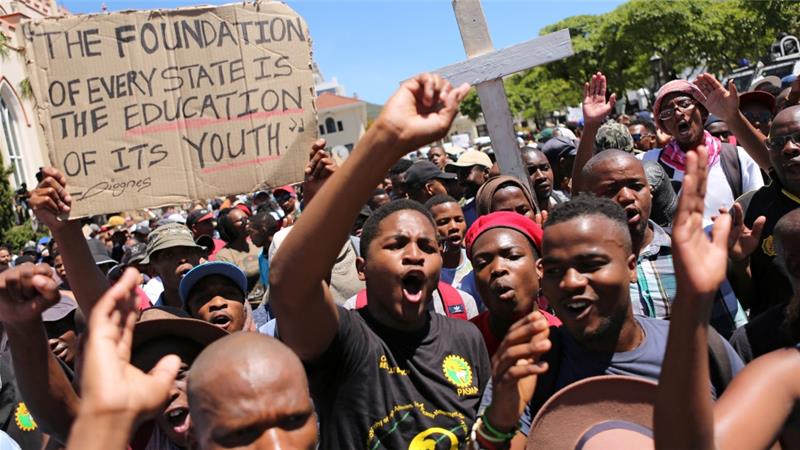 Students protest outside parliament before Finance Minister Pravin Gordhan’s medium-term budget speech in Cape Town [Reuters]
Students protest outside parliament before Finance Minister Pravin Gordhan’s medium-term budget speech in Cape Town [Reuters]
#FeesMustFall: Decolonising education
It is not the first time South Africa has seen student mobilisation. Fees protests, campus shutdowns and mass political violence and repression have been held at historically black universities and colleges for a long time.
What makes the 2015-16 period distinct is that for the first time our student movement spread on to historically white universities, which opened doors to all South Africans after the fall of apartheid in 1994, but continued to retain their colonial foundations.
With this expansion returned the demand for decolonisation of education, echoed in the 2015 #RhodesMustFall campaign at the University of Cape Town, along with long-standing calls for free education and the end to outsourcing practices for campus workers.
#FeesMustFall in many campuses strategically rejected the vertical hierarchies of student representative councils as the only “legitimate voice” of student demands.
… South Africa’s educational system is still rooted in the colonial and apartheid eras, and their injustices persist in its structure and financial set-up.
Both private and public universities in South Africa charge fees and offer different amounts of financial aid along with a national loans system. Over the years, enrolment in the country’s 26 higher education institutions has steadily grown and in 2017 it is expected to reach 1,053,420.
While the intake of students considerably increased, the government’s contribution to universities’ income decreased by 18.4 percent, with the total state budget for public higher education accounting for only 0.74 percent of the gross domestic product.
… This means that an overwhelming number of South Africans need loans for education which enslave the working class and the historically disadvantaged in a debt cycle reinforcing the inequalities carved out by colonialism and apartheid.
… In their struggle for decolonised education, students have pressed even further and have questioned the socially established role of universities and the apparent Eurocentric biases in curricula. There have been calls for decolonisation as it pertains to what is taught and how it is taught.
Conversations that were once relegated strictly to the humanities are spilling over into other departments, faculties and disciplines in ways that will hopefully consolidate them in the future, as repositioning and reconstructive efforts begin to take root.
___________________________________________________
December 14, 2015
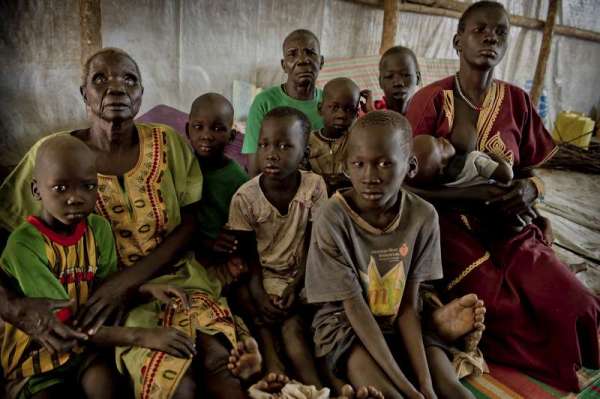
Refugees from South Sudan, Dzaipi transit centre in northern Uganda. (c)UNHCR/F. Noy
Geneva-Doha — Educate A Child (EAC), a global programme of the Education Above All Foundation, and UNHCR, the UN Refugee Agency, are launching a new three-year partnership that will provide access to education for 710,000 children affected by conflict and forced displacement in Africa, Asia and the Middle East.
Building on a partnership that has given more than 260,000 vulnerable children access to primary school since 2012, the new EAC-funded programme will continue to support the education of these children and help enrol a further 450,000 in schools over the next three years. About half of the beneficiaries are expected to be children displaced by the Syria crisis, with the rest in Chad, Ethiopia, the Islamic Republic of Iran, Kenya, Malaysia, Pakistan, Rwanda, Sudan, South Sudan, Uganda and Yemen.
Wars, conflict and persecution in recent years have forced millions to flee their homes and seek refuge and safety elsewhere. The number of forcibly displaced people stood at almost 60 million at the end of 2014. Children make up half of the world’s refugees, and they face the greatest risks from conflict and displacement.
___________________________________________________
November 23, 2014
Bringing Education to African Girls
THE HAGUE — Two decades ago, when Ann Cotton, a British educator and philanthropist, started examining the problem of low school enrollment among girls in rural Zimbabwe, she was struck by the crushing poverty, which to her presented an even bigger obstacle to girls’ education than tradition.
Families did not have enough money for school fees, uniforms or books, and would spend what little they had on the education of their sons, who were more likely to get paid jobs.
On Nov. 4, Ms. Cotton was awarded the World Innovation Summit for Education prize for her role as founder and director of Camfed, an organization that has helped millions of young girls in sub-Saharan Africa remain in school.
___________________________________________________
June 17, 2013
A distressing trend in Western Africa.
___________________________________________________
January 25, 2013
Too Little Access, Not Enough Learning: Africa’s Twin Deficit in Education
Africa’s education crisis seldom makes media headlines or summit agendas and analysis by the Brookings Center for Universal Education (CUE) explains why this needs to change. With one-in-three children still out of school, progress towards universal primary education has stalled. Meanwhile, learning levels among children who are in school are abysmal. Using a newly developed Learning Barometer, CUE estimates that 61 million African children will reach adolescence lacking even the most basic literacy and numeracy skills. Failure to tackle the learning deficit will deprive a whole generation of opportunities to develop their potential and escape poverty. And it will undermine prospect for dynamic growth with shared prosperity.
Read the Brookings report and use the Africa Learning Barometer here.
___________________________________________________
November 14, 2012
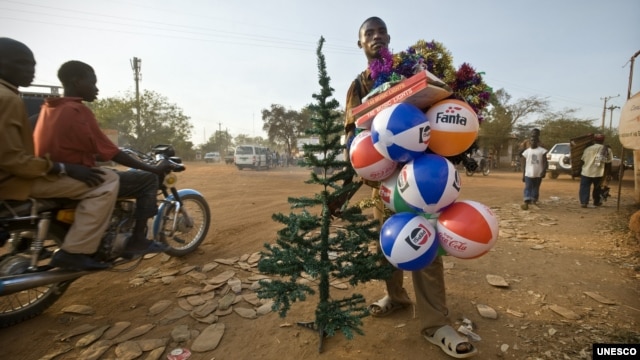
UN Report Finds Africa Education Goals Stagnating
A new report from the United Nations shows progress toward education goals in Africa is stagnating, leaving many young people deprived of quality schooling and high-paying jobs.
According to the 2012 Education for All monitoring report, nearly half of the world’s children who do not go to school reside in just 12 countries, eight of which are in sub-Saharan Africa.
And while the numbers are improving in other parts of the world, the number of out-of-school African children has actually increased in the last couple of years – and is now at 31 million.
The statistics for African school-aged children are part of a troubling trend highlighted in the annual report commissioned by the United Nations education agency UNESCO…
___________________________________________________
September 26, 2012
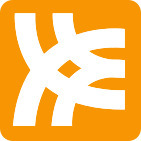
I’m glad to see news of Worldreader.org is making its way into the mainstream media and onto the kitchen table of my parents’ home, because it is a fantastic program. I interviewed Risher in March, 2010, for TKC 88 of the podcast. His bold vision of bringing eReader technology to students around the world combines idealism with the practical advantages of E Ink technology.
The Wall Street Journal reports that Risher has raised about $1.5 million for the program. It has distributed 1,100 Kindles and 180,000 eBooks to pupils and teachers in Ghana, Kenya, and Uganda. Click hear to learn about several ways you can support Worldreader.
Yeah, we want the BooksOpen Scholars to have loaded Kindles…
___________________________________________________
November 15, 2011

World Bank: The Road to Academic Excellence – The Making of World-Class Research Universities
Abstract: How do you build a world-class research university from scratch? In today’s ever-faster, global economy, many countries are reflecting on the merits of building elite global universities to make their mark in world research. Recognizing that such universities are emerging as the central institutions of the 21st Century’s knowledge economies, a new book ‘The Road to Academic Excellence: The Making of World-Class Research Universities’ examines the recent experience of 11 universities in 9 countries on 4 continents that have grappled with the challenges of building successful research institutions under difficult circumstances, and synthesizes the lessons learned. This book will be essential reading for governments, tertiary education leaders, employers, and citizens, considering reforms and innovations to improve their country’s position in the global scene.
Chapter 7 – The Rise, Fall, and Reemergence of the University of Ibadan, Nigeria
African universities of the 1948 generation (preindependence era)—University of Ibadan, Nigeria; University of Khartoum, Sudan; University of Ghana in Legon, Ghana; Makerere University, Uganda; and University Cheikh Anta Diop of Dakar, Senegal—were affiliated with partner universities in the colonizing countries, such as France, Portugal, and the United Kingdom. Through these affiliations, the institutions automatically became part of the French, Portuguese, U.K., or other systems of quality assurance through their partner universities. This type of close administrative and curricular alliances provided African countries with educational qualifications comparable to the academic standards, culture, and character of European universities of that time.
Upon independence, the increased power of state authority over higher education altered the autonomy of the institutions. National government priorities included increased access, tuition-free education, and measures to control political dissent, which was often seen as originating in the universities. Between 1985 and 2002, the number of tertiary students in Sub-Saharan Africa increased 3.6 times (from 800,000 to about 3 million), on average by about 15 percent yearly. The public’s demand for tertiary education is shaped in part by overall trends in population growth and, in 196 The Road to Academic Excellence part, by trends in access at the lower educational levels. The youth population in Sub-Saharan Africa already constitutes more than four times its 1950 level. With broadening access to lower levels of education, pressures to access tertiary education are expected to intensify. Meanwhile, the
education system inherited from the colonial past did not adapt to the countries’ social and economic transformation, remaining rooted in traditional, hierarchical academics meant for the elites.
Private provision of higher education has been expanding in response to the increasing demand for access. The fastest-growing private institutions are the nonuniversity tertiary ones, and they generally feature programs that emphasize social sciences, economics and business, and law because of their lower start-up costs. They undertake little research and tend to respond to student interest rather than labor-market demand. The expansion in enrollments has taken a harsh toll on public resources.
Expenditure per student decreased from US$6,800 in 1980 to US$1,200 in 2002, recently averaging US$981 in 33 low-income countries in Sub- Saharan Africa. The decline in unit costs has affected the quality of education programs. Tertiary institutions are finding it increasingly difficult to recruit and retain teaching staff, lecture halls are overcrowded, equipment is outdated, and few postgraduate programs exist. These factors were exacerbated by the economic and political crises that rocked the region in the past 40 to 50 years. The consequence of this environment is the inability of universities in most of Africa (with the possible exception of South Africa) to keep pace with global developments in the management of universities as well as in curricula, teaching, and research.
___________________________________________________
June 10, 2011
Quick question: Could Africa risk putting too much emphasis on science and technology education? What are the consequences (i.e., lost opportunity) of de-emphasizing the liberal arts? For a U.S.-hued debate on this, see here.
Africa has enjoyed healthy growth over recent year, but to help maintain this growth, it needs to harness Science and Technology Innovations (STI). That means training people for STI, integrating into the global market, and preparing to compete hard in a world fueled by information and driven by knowledge, experts said at the Annual Meetings of the African Development Bank Group (AfDB) on 6 June, 2011.
Addressing a forum at the Meetings held in Lisbon, Mr Boukary Savadogo, the Division Chief Education at AfDB, stressed that African countries need to find better ways of unlocking the potential that science and technology have for development.
In particular, this means boosting investment in higher education and focusing more on science and technology in colleges.
“In our particular case we want to use the entire education system to help promote science and technology,” said Mr Savadogo.
Mr Savadogo said the Bank will increase support to higher education institutions to improve the relevance and quality of training, through its Higher Education, Science and Technology (HEST) strategy. HEST, he explained, aims at helping develop strategies to tackle the high levels of unemployment among graduates, support partnerships and develop knowledge networks.
Mr Savadogo continued: “We want to promote STIs at all levels of the education system because we feel that excellence in STI does not begin at the higher education level; in fact it makes sense to help even children at primary level to start developing a passion for science and technology so that by the time they reach secondary they are already convinced of the importance of science and technology.”
“STI is the only way to be able to have long-term economic growth; it is important that people be taught how to innovate as early as possible,” he said.
Mr Paul Ginies, the Director General of 2ie Foundation, International Institute for Water and Environmental Engineering, Burkina Faso, also pointed out the importance of STI investment in job creation.
“The priority in Africa is employment. We have to guarantee that graduates have access to jobs not just diplomas/degrees.”
Dr Agnes Soucat, AfDB’s Director of Operations, Human Development, emphasized the need to transform Africa’s higher education systems to help produce entrepreneurs that will create jobs.
“Most of the universities on the continent still carry the legacy of being universities that train civil servants, but the civil service cannot be the only job opportunity for the people of tomorrow, especially if you have an increasing number of graduates,” she said, supporting the need to increase investment in STIs.
While enrolments in higher education in Sub Saharan Africa (SSA) are estimated to reach almost 10 million by 2020, graduate unemployment is increasing. It is projected to reach an average of 37 percent in SSA countries, with peaks nearing 50 percent by 2020.
Those alarming forecasts highlight the pressing need for strategies and policies to bridge the gap between skills and labor market demands.
___________________________________________________
June 07, 2011
IRIN Analysis: Sex Abuse in Kenyan Schools
A 2009/2010 government report showed that at least 1,000 teachers had been dismissed from duty in that period for sexually abusing children. A separate study conducted between 2003 and 2009 revealed that 12,660 girls were sexually abused by their teachers, yet only 633 teachers were charged with sexual offences. Furthermore, 90 percent of sexual abuse cases involving teachers never reached the Teachers’ Service Commission (TSC), responsible for monitoring and implementing teachers’ codes of conduct.
A 2009 study by Kenyatta University of more than 1,200 girls in 70 schools across 10 Kenyan districts found that when girls were impregnated by teachers, 45 percent of teachers suffered minor consequences, either a demotion, a transfer to another school or marrying the pregnant girl; an estimated 32 percent of teachers faced no consequences, while 25 percent were sacked. On the other hand, an estimated 76 percent of girls dropped out of school, with many others getting married, procuring abortions and even committing suicide; only 1 percent of those who left were able to rejoin school.
While the study found that 22 percent of teachers who impregnated girls were arrested, government and NGO officials say convictions for teachers who abuse children are rare, mainly due to the fact that unless a girl is pregnant, sexual abuse is difficult to prove. In addition, stigma means many families would rather keep the abuse under wraps and teachers often pay families to keep the cases out of court.
According to Patricia Nyamolo, coordinator of Positive Mentors, a local NGO providing life skills to young girls, shame is another factor that prevents children and families from reporting these crimes.
“Many families still view sexual abuse of children as too stigmatizing to be made public and they don’t report [it], making it extremely hard to implement the law… so it is kept under the rug and only when the child becomes HIV-positive or pregnant is it realized that someone must have been sexually abusing them.
“Head teachers rarely report abuse of children, either because they are the culprits or are acting to protect the image of the school,” she added. “Many schools in Kenya are also sponsored by religious institutions who would normally want to keep such cases under wraps.”
___________________________________________________
June 06, 2011
Child-friendly schools inspire a brighter future for South Africa’s young people
By Thierry Delvigne-Jean, UNICEFAt first glance, nothing distinguishes Makgofe high school in Limpopo province from most other schools in the country. But behind the bricks and mortar, the school has seen an impressive transformation. For the past couple of years, it has outperformed most other schools in the province.
In just a few years the school has gone from being ‘critical’ – a category reserved for schools suffering from extreme levels of poverty, high dropout rates and low pass rates – to one of the best. This is no small achievement in this poor, rural community, where children face many odds.
The school is part of the child-friendly school initiative – known in South Africa as the ‘Safe and Caring Child-Friendly School’ programme – that is being implemented by the Department of Education, with support from UNICEF and non-governmental organisations such as Link Community Development.
Child-friendly schools aim to increase access, retention, completion and learning achievement for the most vulnerable children by promoting life skills, community participation, and health and safety.
It’s also about equipping and empowering boys and girls with the knowledge and confidence they need to make their way through the daily perils of growing up – such as teenage pregnancy and alcohol abuse.
Abigail Setati, a soft-spoken and determined woman, has been the school’s principal since 2008. “We see ourselves as one family, with a common goal,” she says. With more than 1000 students and 33 teachers, she runs a tight ship.
She is well aware that getting children to school and keeping them there is only half the challenge. Creating favourable conditions for children to learn and thrive has proven to be much more challenging.
In rural communities like Makgofe village, children from disadvantaged backgrounds have to work harder to achieve their dreams due to poverty, long walks to school and a lack of educational materials.
The Girls and Boys Education Movement (GEM/BEM) clubs are a key element of the child-friendly school programme. They help learners to recognise and make the most of their potential. “The club has helped me to be positive about myself,” says Kgothatso. “We look at issues in the schools and we come up with ways to address these issues.” Using drama, poetry and other activities, the members of the school clubs – ‘gembemmers’ as they are known – show initiative and entrepreneurship in the face of adversity.
“Some children tell me ‘how am I going to go to school today if I have nothing in my stomach?’” says Kgothatso. “So we started a garden behind the school to help feed those who don’t have enough to eat at home.”
Ms. Setati says that this holistic approach to education has made the difference. “Our school goes beyond the curriculum,” she explains. “We teach them things that are not in the formal curriculum but that are important – social skills, for example, like how to greet and support each other.”
For Ms. Setati, the success of the programme is in its rights-based approach. “We involve learners – through the learners’ council – in every decision we make, so learners are part of the process,” she says, adding that every decision the school makes is designed to be child-friendly.
Another strength of the initiative, according to Guy Bostock, the Link Community Development coordinator who oversees the implementation of the programme in Limpopo, is that the child-friendly school programme can be adapted to each individual school’s needs.
___________________________________________________
June 02, 2011
Gates Foundation spends $1.7B on farming in Africa
By DONNA GORDON BLANKINSHIP, Associated PressSEATTLE (AP) — The world’s largest charitable foundation announced five years ago it would spend millions of dollars to fight poverty and hunger in Africa, largely by investing in agriculture. To date, the Bill & Melinda Gates Foundation has committed $1.7 billion, but its leaders say it could take 20 years to see the results of that work.
The foundation has focused on ways to bring to Africa the green revolution that swept Latin America and Asia in the mid-1900s, boosting productivity in those regions. Its hope has been that helping small farmers grow more would allow them to sell their surplus, boosting their income and putting more food in hungry mouths. More than 70 percent of the world’s poor depend on agriculture for both their food and income.
The foundation, he said, aims to prevent crises by strengthening agriculture systems.
It’s an approach anti-hunger organizations such as CARE and the United Nation’s World Food Programme also are taking. One-fifth or less of CARE’s budget now goes to the kind of direct food aid the nonprofit was created to provide 65 years ago. The rest is focused on agriculture development work similar to what the Gates Foundation is doing.
Gates Foundation believes it can move more than 150 million in Africa out of extreme poverty by 2025 by improving agriculture. To that end, it has invested millions in seed research, buying and distributing fertilizer, improving farmers’ education and access to markets and political advocacy to get governments to spend more money on agriculture and to improve policies ranging from trade to land ownership.
Much of the work has been done through the Alliance for a Green Revolution in Africa, which is run by Africans with heavy support from the foundation. AGRA has used Gates money to support plant breeding programs at nine African universities, help seed companies increase their production, set up soil mapping programs and provide credit to help seed, fertilizer and equipment suppliers expand, among other things.
One of its biggest challenges has been a lack of education among farmers. “We want to make sure that we are really making things better over the long term, not making them worse,” he said.
Another big chunk of Gates Foundation money, $66 million, has been promised to the World Food Programme to help improve African farmers’ access to markets.
___________________________________________________
May 31, 2011

UNESCO launches Global partnership for Girls and Women’s Education
World political and corporate leaders today launched a major new Global Partnership for Girls’ and Women’s Education during a High-Level Forum held at UNESCO Headquarters. UNESCO Director-General Irina Bokova welcomed the participants to the Forum which aimed to galvanize support from the private and public sectors to make quality education available for girls and women everywhere.
Globally, some 39 million girls of lower secondary age are currently not enrolled in either primary or secondary education, while two thirds of the world’s 796 million illiterate adults are women. Only about one third of countries have achieved gender parity at secondary level.
“There are no immovable barriers to gender equality and education for all,” Irina Bokova said. “Young girls and women are changing the world, we must support them. We must give them the tools they need to shape the world as they wish.”
United Nations Secretary-General Ban Ki-moon struck a personal note in his opening remarks, as he recalled his childhood as a displaced person at the close of World War II when his mother, like other women enjoyed little help bringing children into the world…
U.S. Secretary of State Hillary Rodham Clinton spoke of her commitment to UNESCO’s ideals and achievements. The Secretary of State announced that the U.S. will support UNESCO’s work in collating data on gender and education, saying that “more data will help target investment where it will have the greatest impact.” She also stressed the potential of partnerships, notably with the private sector, to raise funds and, equally importantly, to find creative new ways for more effective action.”
In her keynote address, the Prime Minister of Bangladesh Sheikh Hasina pointed out that “If you educate a boy, you educate one boy, whereas if you educate a girl, you educate her entire family and community.”
Other participants in the Forum included the Aga Khan, founder and chairman of the Aga Khan Development Network Foundation and senior representatives of several corporate giants participating in the partnership – including Nokia, Procter and Gamble, GEMS Education, Microsoft and the Packard Foundation.
The Global Partnership for Girls’ and Women’s education will focus mainly on secondary education and adult literacy, especially in Africa and Asia. The High-Level Panel established at the Forum today will complement these efforts by stepping up global advocacy, and acting as a ‘global conscience’ for the advancement of girls and women.
___________________________________________________
May 25, 2011
I’ll try to find some more detailed accounts of China/India investment trends in Africa, but for now, a couple reports from India’s second Africa-India Forum…
India boosts bid to rival China in Africa
By Scott Baldauf
Christian Science Monitor
May 25, 2011
If it wasn’t already clear, India’s announcement of $5 billion in development deals in Africa should certainly put to rest any question of whether India is dedicated to doing business on the African continent over the long haul.
The pledge of development aid to African countries – essentially a fund to help African countries to meet their development goals – stands in stark contrast to Africa’s largest single trading partner, China.
While China trades large infrastructure projects (built mostly by Chinese labor) for access to African raw materials, India spends money on training Africans to develop their own countries. And while Indian countries certainly have come into Africa as investors, Indian diplomats are quick to stress that the relationship between India and African countries is more one of equal partners.
India pledges $5 bn credit to Africa
The Economic Times
May 25, 2011
Prime Minister Manmohan Singh unveiled a slew of initiatives to help African nations build local capabilities, continuing the Indian strategy of treading softly on a continent where there is a scramble for natural resources.
India pledged a $5 billion line of credit for development initiatives and an additional $700 million for education and skill development in Africa, Singh said at the plenary session of the second India-Africa summit here.
India has traditionally adopted a light-footed approach to economic diplomacy in Africa and there have been concerns that the Indian engagement lacked consistency and is not as effective as that of China.
Officials accompanying the prime minister insisted that India’s is not being outsmarted by the Chinese, pointing to the Indian initiatives to build local institutions and capacity in agriculture, education and training.
“The Chinese are absent in many of these areas. We don’t agree that China has outflanked us here. There is enough place to do what we are good at,” said a senior official.
___________________________________________________
May 23, 2011
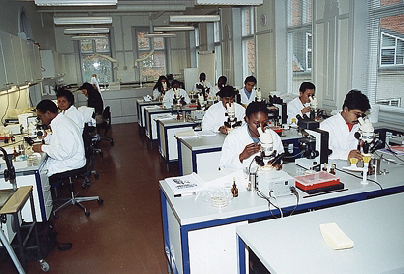 Sokoine University of Agriculture – Morogoro, Tanzania
Sokoine University of Agriculture – Morogoro, Tanzania
Africa: What Does It Take to Compete? The World Bank Africa Competitiveness Report 2011
Much progress has been made in getting children into school and achieving parity between boys and girls in African classrooms at the primary school level, and to a lesser extent at the secondary school level. But while rapid progress has been made in such basic-level enrollments, university enrollment has barely advanced, rising only from 4 percent in 1999 to 6 percent in 2007. Even though African countries have generally spent relatively large proportions of their national resources on education, the stock of human capital with a higher education in Africa continues to be very low by international standards.
Besides, research shows more and more that it is cognitive skills and learning, not years of schooling, that makes the difference. The reason is that cognitive skills could foster innovation and promote technology diffusion by equipping the workforce with the ability to absorb, process, and integrate new ideas into production and service delivery. The areas of higher education undertaken by a majority of African students are not in fields such as science, engineering, technology, and business, as is the case in rapidly growing emerging economies of Korea and China, but often in social sciences and the humanities. The result is a skill mismatch— university graduates remain unemployed, while African countries continue to face shortages of skilled labor.
The good news is that the rate of return to skills is high in Africa. What is therefore needed is a big push on quality education and skills, as was seen in Korea and other East Asian countries to underpin their growth miracles. The finding on the importance of cognitive skills for long-run growth should be a wake-up call for Africa, and should raise questions about the quality of the education now being provided. The thriving telecommunications sector in many African countries can facilitate information transfer, knowledge, and learning. At the same time, tertiary education curricula and pedagogy need to be reformed.
May 20, 2011
Getting Smart on Aid
By NICHOLAS D. KRISTOF
Now we reach a central question for our age: How can we most effectively break cycles of poverty? For decades, we had answers that were mostly anecdotal or hot air. But, increasingly, we are now seeing economists provide answers that are rigorously field-tested, akin to the way drugs are tested in randomized controlled trials, yielding results that are particularly credible and persuasive.
Prof. Michael Kremer, a Harvard economist, helped pioneer randomized trials in antipoverty work. In the 1990s, Kremer began studying how to improve education in Africa, trying different approaches in randomly selected batches of schools.
One intervention he tried was deworming kids — and bingo! In much of the developing world, most kids have intestinal worms, leaving them sick, anemic and more likely to miss school. Deworming is very cheap (a pill costing a few pennies), and, in the experiment he did with Edward Miguel, it resulted in 25 percent less absenteeism. Even years later, the kids who had been randomly chosen to be dewormed were earning more money than other kids.
Kremer estimates that the cost of keeping a kid in school for an additional year by building schools or by subsidizing school uniforms is more than $100, while by deworming kids, the cost drops to $3.50. (In a pinch, kids can usually go to “school” in a church or mosque without a uniform.)
___________________________________________________
May 19, 2011
Sub-Saharan African countries increased their real expenditure on education by more than 6% each year over the past decade, according to a new report published by UNESCO. Yet despite these investments, many countries in the region are still a long way from providing every child with a good quality primary education.
“This report shows very clearly how committed African nations and their partners are to achieving Education for All,” said UNESCO Director-General Irina Bokova. “It also shows that their efforts are paying dividends, with more children going to school than ever before. This is very encouraging and should spur all of Africa’s partners to provide the support that will help fill the remaining gaps.”
“The Education for All message has not fallen on deaf ears,” said UIS Director Hendrik van der Pol. “Now we need to protect these investments from the current economic storms. Strategic decisions will have to be made based on the facts – not assumptions.”
Overall, the increase in investments has been accompanied by some spectacular results. Between 2000 and 2008, the number of children in primary schooling increased by 48% – from 87 million to 129 million. Enrolment in pre-primary, secondary and tertiary education has also grown by more than 60% during the same period.
___________________________________________________
May 18, 2011
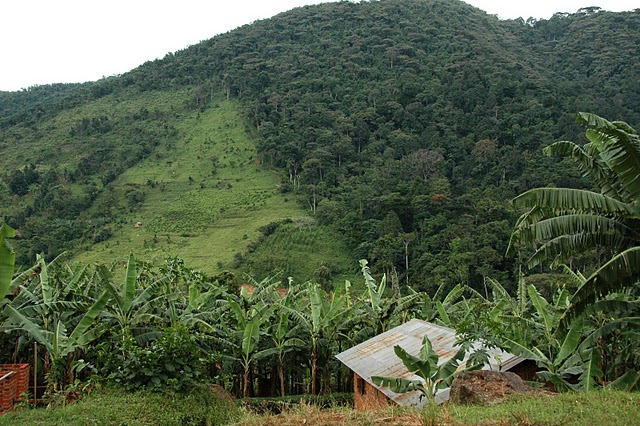
Encouraging Childhood Education and Birth Spacing as an Approach to Conservation
Today, having very large families and depending on farming the land and the forest makes life difficult. “Children should, therefore, be able to go to school,” argues Sam. He realizes that without family planning, it will be hard, if not impossible, for parents to afford to send their children to school. Yet, young people without an education will likely become young people without jobs. This could drive them to the protected forests to illegally trap animals for food and cut timber for fuel and to build houses. In contrast, those with smaller families will have a better chance of educating their children, and in turn, providing them a better chance to secure a job or profession.
(Side note: The New Security Beat is a favorite blog of Nick’s, and the picture in this blog post is the border of Bwindi Impenetrable National Forest, where Nick worked for a year researching mountain gorillas.)
___________________________________________________
December 20, 2010

The Perry Preschool Project is one of the most famous education experiments of the last 50 years. The study asked a question: Can preschool boost the IQ scores of poor African-American children and prevent them from failing in school? The surprising results are now challenging widely-held notions about what helps people succeed – in school, and in life.
___________________________________________________
November 12, 2010
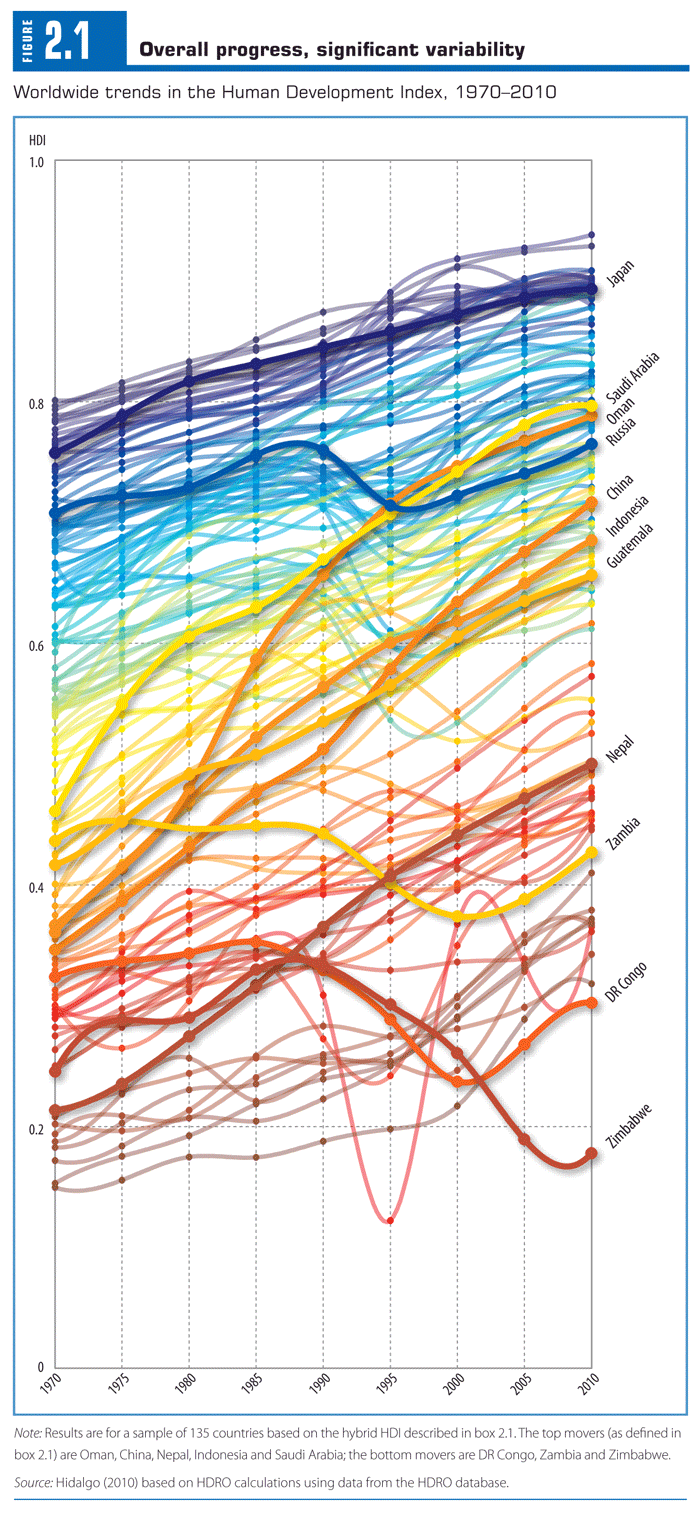 Check out the new Human Development Report 2010, and play around with some interactive statistical tools. Education is a big player in the Human Development Index (HDI).
Check out the new Human Development Report 2010, and play around with some interactive statistical tools. Education is a big player in the Human Development Index (HDI).
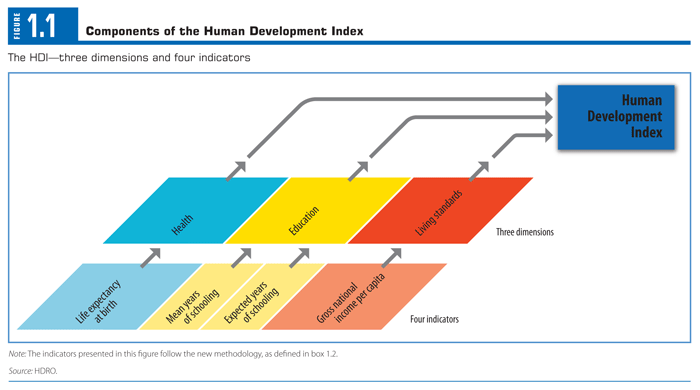 Oh, and by the way, no big changes to the bottom end of the HDI:
Oh, and by the way, no big changes to the bottom end of the HDI:
Low Human Development
128. Kenya
129. Bangladesh
130. Ghana
140. Cameroon
150. Myanmar
151. Yemen
152. Benin
153. Madagascar
154. Mauritania
155. Papua New Guinea
156. Nepal
157. Togo
158. Comoros
159. Lesotho
160. Nigeria
161. Uganda
162. Senegal
163. Haiti
164. Angola
165. Djibouti
166. Tanzania (United Republic of)
167. Côte d’Ivoire
168. Zambia
169. Gambia
170. Rwanda
171. Malawi
172. Sudan
173. Afghanistan
174. Guinea
175. Ethiopia
176. Sierra Leone
177. Central African Republic
178. Mali
179. Burkina Faso
180. Liberia
181. Chad
182. Guinea-Bissau
183. Mozambique
184. Burundi
185. Niger
186. Congo (Democratic Republic of the)
187. Zimbabwe
___________________________________________________
From The New York Times:
August 08, 2010
India Asks, Should Food Be a Right for the Poor?
By JIM YARDLEY
Landless and illiterate, drowned by debt, Mr. Bhuria and his ailing children have staggered into the hospital ward after falling through India’s social safety net. They should receive subsidized government food and cooking fuel. They do not. The older children should be enrolled in school and receiving a free daily lunch. They are not. Read More>>>
(See the FAO report immediately below for an analysis of the
connection between rural education and food security.)
___________________________________________________
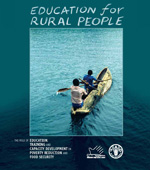
EDUCATION for RURAL PEOPLE: The role of EDUCATION, TRAINING and CAPACITY DEVELOPMENT in POVERTY REDUCTION and FOOD SECURITY
From the Abstract: “The broad background is that studies leading to the formulation of the Millennium Development Goals in 2000 have shown the potential that poor people have to make their living if the right conditions are created. The challenge for the international community is to identify barriers and to create conditions for rural people to change and improve their situation. In this perspective, the way to reach food security is to strengthen the capacity of poor people. The concept of capacity is closely associated with notions such as empowerment. It is generally agreed that education in all its forms is one important pillar in such a strategy. The role of education is not only to impart knowledge and skills but also to contribute to the empowerment of people by improving their self-confi dence, widen their frame of reference and give them the tools to participate in wider processes of social and economic change.”
___________________________________________________
Trailer For “A Small Act”
___________________________________________________
From The Guardian:
February 23, 2010
Lack of transparency undermining primary education in Africa
By Richard M Kavuma and Liz Ford
A glaring lack of mutual accountability between primary schools and parents, poor financial record keeping and bad management is threatening the quality of basic education in seven African countries, including Uganda.
A report by Transparency International (TI), published today, found schools in Uganda, Sierra Leone, Ghana, Senegal, Morocco, Madagascar and Niger had poor governance systems and practices, with limited availability of financial documentation at district education offices and schools, which was impeding progress in achieving the six aims of the Education For All (EFA) initiative and the Millennium Development Goals (MDGs). The survey also revealed a lack of interest by parents in the running of schools.
The report, Africa Education Watch: Good governance lessons for primary education, examined primary education management structures in the seven African states, analysing data from 8,500 questionnaires completed by parents, headteachers, the heads of parent teacher associations (PTAs) and district education officers.
The report’s publication comes as the three-day EFA high level group meeting opens in Ethiopia. The annual meeting, which runs until Thursday, will bring together representatives from national governments, NGOs, UN agencies, civil society groups and the private sector to discuss progress towards the EFA goals and the MDGs. The meeting will consider recommendations made in the EFA global monitoring report, published in December, that examined the impact of the global financial downturn on education. The report was highly critical of national governments and the donor community’s commitment to meeting education targets. Read More >>>
(BooksOpen Foundation recognizes the shortcomings of public education in many parts of Africa, and is dedicated to sending relatively disadvantaged children to reputable boarding schools.)
_______________________________________________________
Thoughts on how we define poverty and the limits to opportunity
_______________________________________________________
From NYT:
Aid Gives Alternative to African Orphanages
MCHINJI DISTRICT, Malawi — The Home of Hope orphanage provides Chikodano Lupanga, 15, with three nutritious meals a day, new school uniforms, sensible black shoes and a decent education.
Her orphaned cousin Jean, 11, who balked at entering the orphanage and lives with her grown sister, has no shoes, raggedy clothes and an often-empty belly. Repeating third grade for the third time, Jean said she bitterly regretted that she did not grow up in the orphanage where Madonna adopted a boy. Had she stayed, she whispered, “I would have learned to read.”
In a country as desperately poor as Malawi, children placed in institutions are often seen as the lucky ones. But even as orphanages have sprung up across Africa with donations from Western churches and charities, the families who care for the vast majority of the continent’s orphans have gotten no help at all, household surveys show.
Researchers now say a far better way to assist these bereft children is with simple allocations of cash — $4 to $20 a month in an experimental program under way here in Malawi — given directly to the destitute extended families who take them in. That program could provide grants to eight families looking after some two dozen children for the $1,500 a year it costs to sponsor one child at the Home of Hope, estimated Candace M. Miller, a Boston University professor and a lead researcher in the project. Read More >>>
_______________________________________________________
From IPS:
MALAWI: Pre-school Education A Luxury
By Claire Ngozo
LILONGWE, Sep 28 (IPS) – Less than a third of Malawi’s children attend pre-school; the others will lag behind their peers for their entire school careers.
For most Malawian children, school only starts at the age of six – or sometimes even later – when they enter primary school. Pre-schools are mainly privately-owned and regarded as a luxury since most families cannot afford to pay the fees.
In Malawi, up to 60 percent of the population lives below the poverty line of $1 a day, according to United Nations statistics, while pre-school fees, for the few Malawians who earn a good income, range from $50 to $800 per term.
Not attending a pre-school means that most of the country’s children miss out on early learning and stimulation, according to the country’s secretary for gender, children and community development, Olive Chikankheni.
The United Nations Children’s Fund (UNICEF) indicates that early childhood development is critical for the formation of intelligence, personality and social behavior. The effects of neglect in these formative years can be cumulative and lasting.
“Most nursery schools are in urban areas and demand very high school fees, which most people cannot afford,” confirmed Chikankheni. About 60 percent of Malawi’s population live in the country’s rural areas, however, where poverty is rife. Read More>>>
_______________________________________________________
___________________________________________________________
